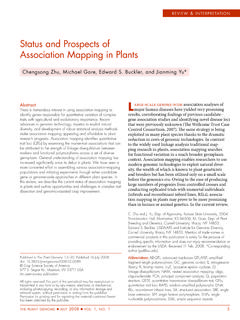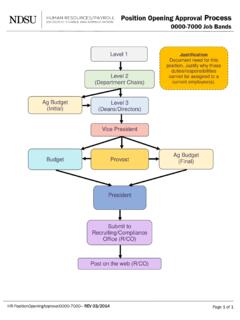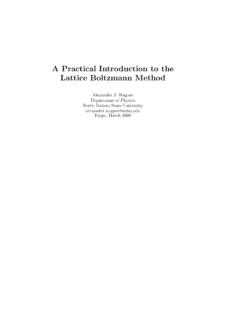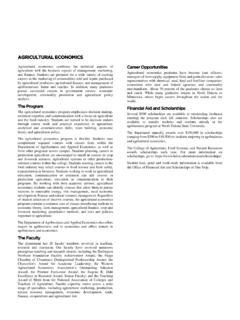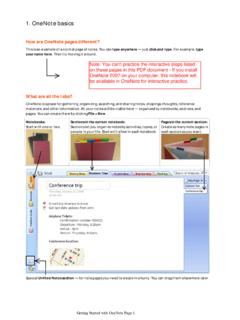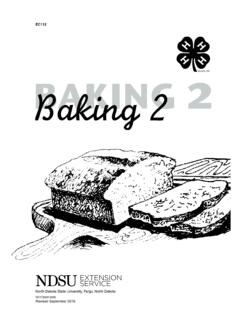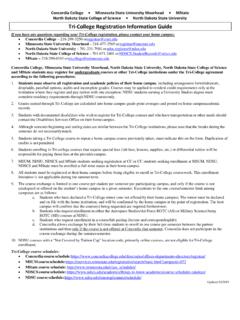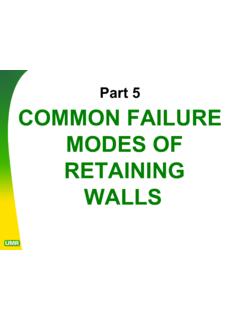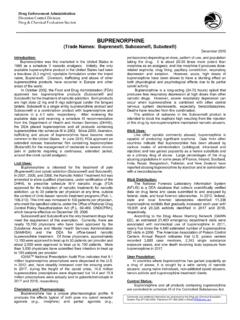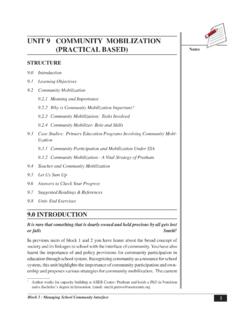Transcription of RANDOMIZED COMPLETE BLOCK DESIGN (RCBD)
1 RANDOMIZED COMPLETE BLOCK DESIGN (RCBD) Description of the DESIGN Probably the most used and useful of the experimental designs. Takes advantage of grouping similar experimental units into blocks or replicates. The blocks of experimental units should be as uniform as possible. The purpose of grouping experimental units is to have the units in a BLOCK as uniform as possible so that the observed differences between treatments will be largely due to true differences between treatments. Randomization Procedure Each replicate is RANDOMIZED separately. Each treatment has the same probability of being assigned to a given experimental unit within a replicate. Each treatment must appear at least once per replicate. Example Given four fertilizer rates applied to Amidon wheat and three replicates of each treatment.
2 Rep 1 Rep 2 Rep 3 A B A A=0 kg N/ha D A B B=50 kg N/ha C D C C=100 kg N/ha B C D D=150 kg N/ha Advantages of the RCBD 1. Generally more precise than the CRD. 2. No restriction on the number of treatments or replicates. 3. Some treatments may be replicated more times than others. 4. Missing plots are easily estimated. 5. Whole treatments or entire replicates may be deleted from the analysis. 1 6. If experimental error is heterogeneous, valid comparisons can still be made. Disadvantages of the RCBD 1. Error df is smaller than that for the CRD (problem with a small number of treatments). 2.
3 If there is a large variation between experimental units within a BLOCK , a large error term may result (this may be due to too many treatments). 3. If there are missing data, a RCBD experiment may be less efficient than a CRD NOTE: The most important item to consider when choosing a DESIGN is the uniformity of the experimental units. RCBD No Sampling Example Grain yield of rice at six seeding rates (Mg/ha): Seeding rate (kg/ha) Rep 25 50 75 100 125 150 2ijY Step 1.
4 Calculate the correction factor (CF). * 2 Step 2. Calculate the Total SS. ) ( 22222= ++++= = CFCFYSST otalij Step 3. Calculate the Replicate SS (Rep SS) () +++= = CFCFtYSSj Step 4. Calculate the Treatment SS (Trt SS) () +++++= = CFCFrYSSTrti Step 5. Calculate the Error SS Error SS = Total SS Rep SS Trt SS = 3 Step 6. COMPLETE the ANOVA Table SOV Df SS MS F Rep r-1 = 3 MS/Error MS = **Trt t-1 = 5 MS/Error MS = (r-1)(t-1) = 15 Total tr-1 = 23 Step 7. Look up Table F-values for Rep and Trt: Rep ;3,15 = ;5,15 = ;3,15 = ;5,15 = Step 8. Make conclusions. Rep: Since Fcalc.( ) > FTab. at the 95 and 99% levels of confidence, we reject Ho: All replicate means are equal.
5 TRT: Since Fcalc.( ) < FTab. at the 95 and 99% levels of confidence, we fail to reject Ho: All treatment means are equal. Step 9. Calculate Coefficient of Variation (CV). % * *===YsCV Step 10. Calculate LSD s if necessary There is no need to calculate a LSD for replicate since you generally are not interested in comparing differences between replicate means. Since the F-test for treatment was non-significant, one would not calculate the F-protected LSD. However, if the F-test for treatment was significant, the LSD would be: 4 ) ( Significance of F-tests on Replicate This is a valid F-test but requires careful interpretation. If the F-test for replicate is significant, this indicates that the precision of the experiment has been increased by using this DESIGN instead of a CRD.
6 This suggests that the scope of the experiment may have been increased since the experiment was conducted over a wider range of conditions. One needs to be careful when replicate effects are large because this suggests heterogeneity of error may exist. If replicate effects are small, this suggests that either the experimenter was not successful in reducing error variance of the individual experimental units or that the experimental units were homogenous to start. To know which situation is true in your case, you need to have the experience of knowing the typical size of the Rep MS. Missing Data For each missing value in the experiment, you loose one degree of freedom from error and total. Reasons for missing data include: 1.
7 Animal dies 2. Break a test tube. 3. Animals eat grain in the plot. 4. Spill grain sample. 5 The value for a missing plot can be estimated by using the formula: )1)(1()( +=trGtTrBYij where: r = number of replicates t = number of treatments B = replicate total of replicate with missing value T = treatment total of treatment with missing value G = Experiment total ( ) Example Suppose you have the following data and analysis with no missing data: Treatment Rep A B C D 9 11 3 7 30 2 8 13 5 10 36 3 7 12 8 4 31 36 16 21
8 97 SOV Df SS MS F Rep 2 3 *Error 6 11 Now assume the value for Y32 is missing. Treatment Rep A B C D 9 11 3 7 30 2 8 13 10 31 3 7 12 8 4 31 36 11
9 21 92 6 Step 1. Estimate the missing value for Y32 using the formula: [] )14)(13(92)11*4()31*3()1)(1()(= += +=trGtTrBYij Step 2. Substitute the calculate value into the missing spot in the data. Treatment Rep A B C D 9 11 3 7 30 2 8 13 10 3 7 12 8 4 31 36 21
10 Step 3. COMPLETE the analysis. Remember that you will loose one degree of freedom in error and total for each missing value. SOV Df SS MS F Rep 2 3 5 10 Facts About the Missing Value Analysis Use of the estimated value does not improve the analysis or supply additional information. It only facilitates the analysis of the remaining data. The Error MS calculated using the estimate of the missing value is a minimum. Use of any other value but the one calculated would result in a larger value.

